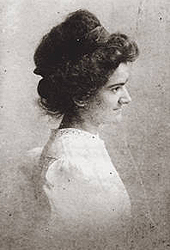Maga Magazinovic a Pioneer of modern dance in Serbia
 As a performing art, ballet arrived in Serbia much later than in western Europe or in Russia. In the early 20th century, only some enthusiasts in Belgrade were interested in dance and ballet as a form of art. The first and the most dedicated champion of dance as an official form of art in Serbia was Maga Magazinović (1882–1968), a person of versatile talents, who was always ahead of her time. She was the first woman to graduate from the Faculty of Philosophy in Belgrade and the first woman who wrote for the POLITIKA daily. Marija - Maga Magazinović was born in Užice, Western Serbia, in 1882. She graduated from the Faculty of Philosophy in Belgrade in 1904, in the class of distinguished Serbian philosopher Branislav Petronijević.
As a performing art, ballet arrived in Serbia much later than in western Europe or in Russia. In the early 20th century, only some enthusiasts in Belgrade were interested in dance and ballet as a form of art. The first and the most dedicated champion of dance as an official form of art in Serbia was Maga Magazinović (1882–1968), a person of versatile talents, who was always ahead of her time. She was the first woman to graduate from the Faculty of Philosophy in Belgrade and the first woman who wrote for the POLITIKA daily. Marija - Maga Magazinović was born in Užice, Western Serbia, in 1882. She graduated from the Faculty of Philosophy in Belgrade in 1904, in the class of distinguished Serbian philosopher Branislav Petronijević.
In 1909, she left for Berlin, where she studied the German language and history of art. She studied ballet with the most famous artists and theoreticians of those times, theatre and film director Max Reinhardt and famous ballet dancer Isadora Duncan. In Belgrade, in 1910, with an approval of the Ministry of Education, she opened The School for Declamation, Aesthetic Gymnastics and Foreign Languages. The name was inspired by the then education minister, Jaša Prodanović, who, in a letter of his to Magazinović, wrote: Do not instill fear in people with dance and ballet – name the school as humbly as possible. In 1912/1913 she spent a year in Hellerau, Germany, studying the method of Emile Jaques-Dalcroze, a Swiss composer and musician who developed eurhythmics, a method of learning and experiencing music through movement. When she returned to Belgrade, she renamed her school The School for Rhythmics and Plastics of Maga Magazinović. The school lasted until 1935, parallel with classical ballet education in Belgrade, which began in 1921.
Maga Magazinović was also the first woman librarian in the National Library of Serbia and the first woman who was a journalist by vocation. Immediately after the POLITIKA daily was founded in 1904, she started paving the way for women to journalism, at the time when marriage was considered the greatest success for a woman. She was an editor of a section dedicated to women and also wrote texts on rhythmics and plastics as a form of bodily and spiritual education of young people, especially girls. She also contributed articles to some other magazines and journals and pursued her journalist career for the rest of her life, in addition to teaching and dancing.
In her memoirs, Maga Magazinović describes the atmosphere in which dance was established as art in Belgrade in the early 20th century. The first dancers schooled in classical ballet were Russian emigrees, who arrived in Belgrade as refugees after the October Revolution and began work on the foundation of a ballet ensemble of the National Theatre in Belgrade. The history of ballet in Serbia bears a specific and unique feature – contrary to other European countries and America – modern ballet was established in Serbia before the classical one, for Maga Magazinović founded her school ten years before the official foundation of the ballet ensemble in the Belgrade National Theatre.
The energy Maga Magazinović invested in the development of art of dance in Serbia was admirable. Aspiring to constant professional education, she often attended specialist courses in Europe. After the Second World War, she worked as a teacher in several subjects in the State Ballet School. One of the subjects was the History of Dance, on which topic she wrote the first book in Serbian. For forty years, Maga Magazinović was also a teacher of philosophy, German and Serbian in the First Grammar School for Girls. She died in 1968.
Source:

